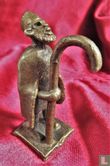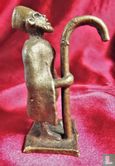These intriguing metal objects come from Africa's 'Gold Coast' - present-day Ghana. They are weights that the traders of the native Asante used to weigh gold dust – the traditional means of payment.
The many gold deposits in the region formed the basis for the wealth of the Asante. Long before the English colonized the area in 1900, gold transports to Sudan, in addition to the trade in salt and slaves, ensured their prosperity. A quantity of gold dust had to be weighed with each transaction.
The weights were made by local blacksmiths. They used the so-called 'lost form' technique for this. A model is made of wax. A lump of clay is placed around it, which is then heated. During this process, the wax melts and drains through previously applied channels. The blacksmith then uses this to pour metal into the mould. When it has cooled down, the clay is broken away.
Traditionally, there are two types of weights: geometric and figurative. The geometric ones are the oldest. The very earliest were barely decorated. At most they had small engravings or holes. Later copies bore owner's marks or symbols such as the rays of the sun, or waves on the water.
The later figurative weights are more imaginative. They often refer to popular Asante proverbs or well-known stories. Also, they often depict events from the lives of their owners. With their deaths, the meaning was often lost as well.
After British colonization, the Asantes were forced to switch to a Western coinage system. The gold weights lost their function and became exotic collectibles.
This text has been translated automatically from Dutch
Click here for the original text
Deze intrigerende metalen voorwerpen komen uit de ‘Goudkust’ van Afrika – het huidige Ghana. Het zijn gewichtjes die de handelaren van de inheemse Asante gebruikten om stofgoud – het traditionele betaalmiddel – af te wegen.
De vele goudvoorraden in de regio vormden de basis voor de rijkdom van de Asante. Al ver voordat de Engelsen het gebied koloniseerden in 1900, zorgden goudtransporten richting Sudan naast de handel in zout en slaven voor hun welvaart. Bij elke transactie moest een hoeveelheid stofgoud worden afgewogen.
De gewichtjes werden door lokale smeden gemaakt. Ze gebruikten daarvoor de zogeheten ‘verloren vorm’-techniek. Daarbij wordt een model gemaakt van was. Eromheen wordt een kleiklomp aangebracht die vervolgens wordt verhit. Tijdens dat proces smelt de was en loopt weg via eerder aangebrachte kanaaltjes. Deze gebruikt de smid vervolgens om metaal in de vorm te gieten. Wanneer dat is afgekoeld wordt de klei weggebroken.
Traditioneel zijn er twee soorten gewichten: geometrische en figuratieve. De geometrische zijn het oudst. De allervroegste waren nauwelijks gedecoreerd. Hooguit hadden ze kleine graveringen of gaatjes. Latere exemplaren droegen kentekenen van de eigenaar of symbolen als de stralen van de zon, of golven op het water.
De latere figuratieve gewichtjes zijn meer fantasierijk. Ze verwijzen vaak naar populaire Asante-spreekwoorden of bekende verhalen. Ook verbeelden ze vaak gebeurtenissen uit het leven van hun eigenaren. Met hun dood ging vaak ook de betekenis verloren.
Na de Britse kolonisatie werden de Asante gedwongen over te stappen op een Westers stelsel met muntgeld. De goudgewichtjes verloren hun functie en werden exotische verzamelobjecten.











